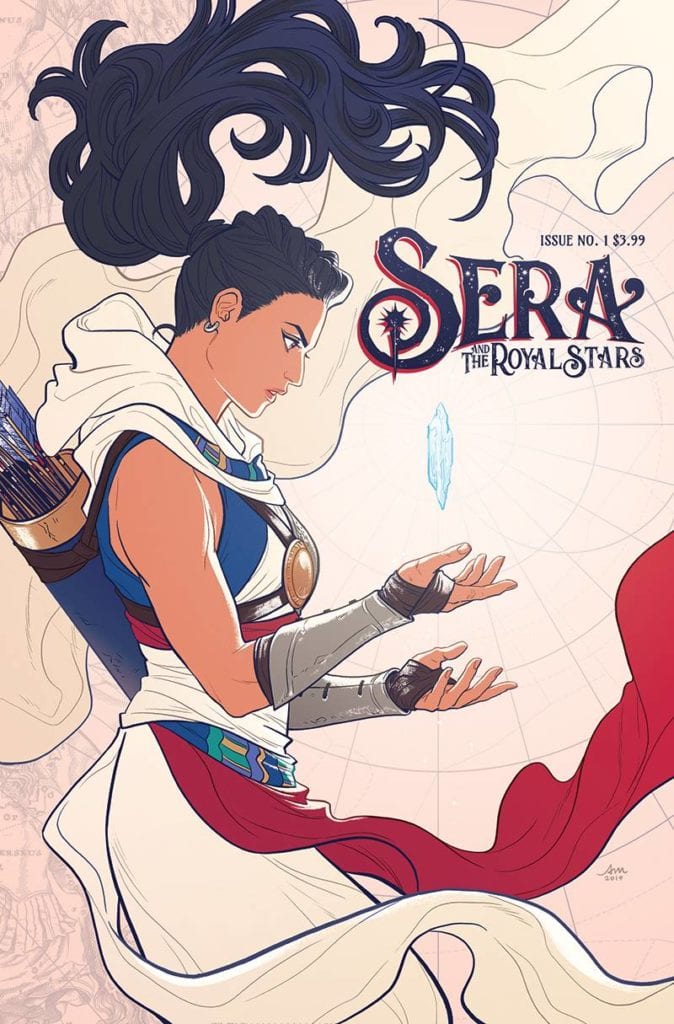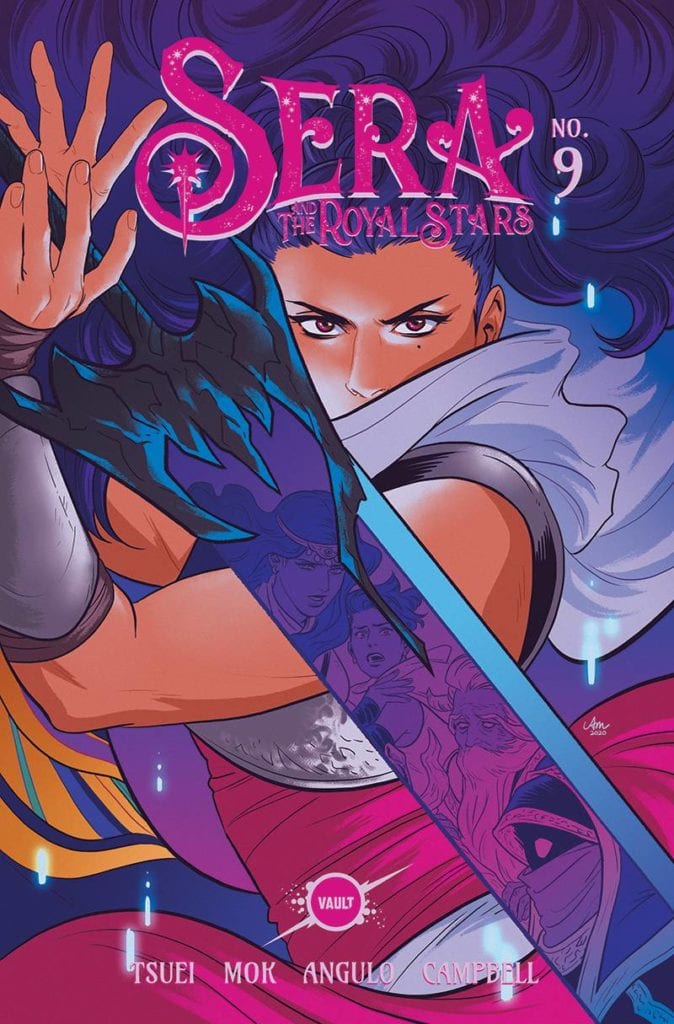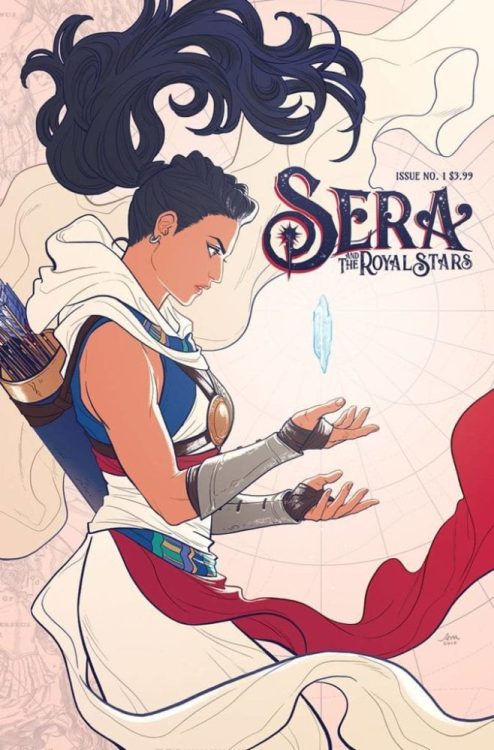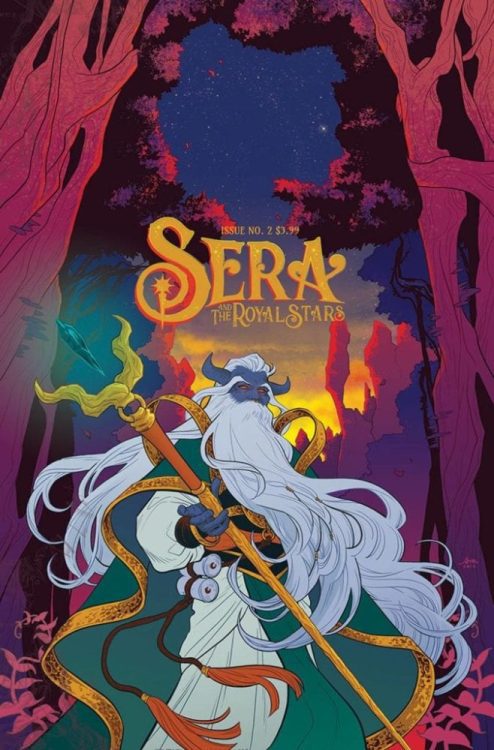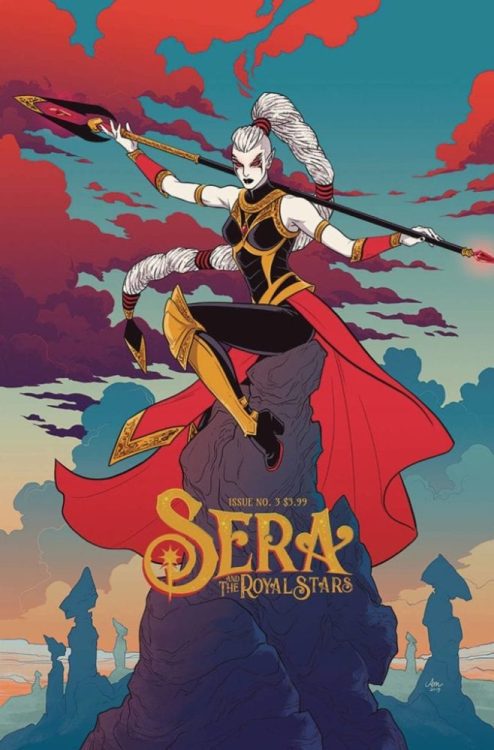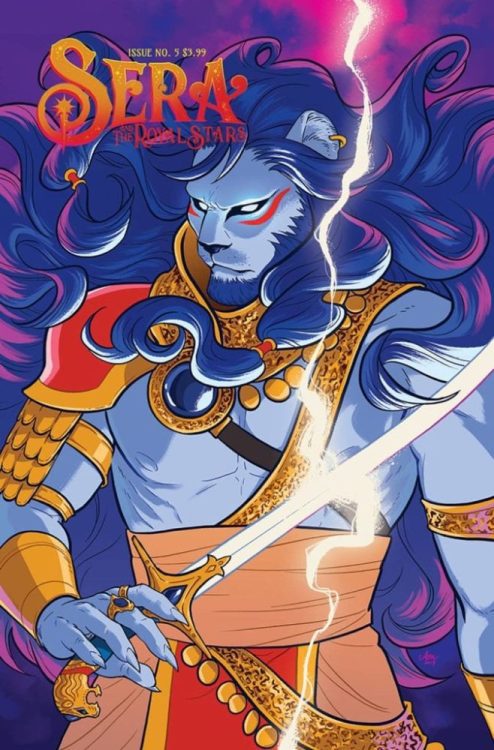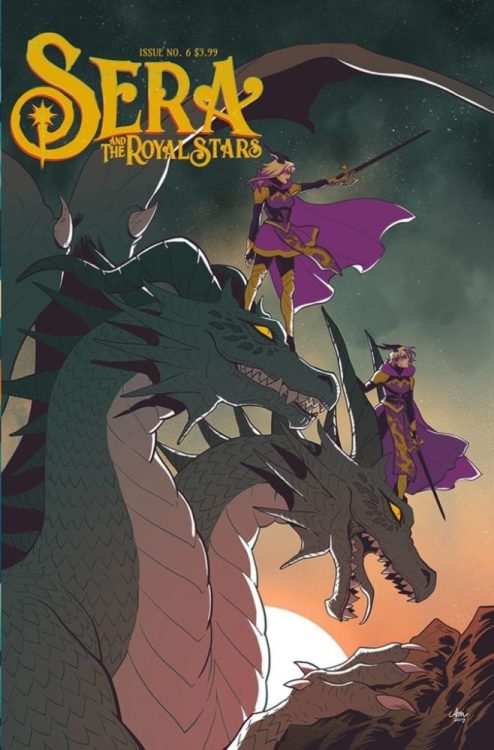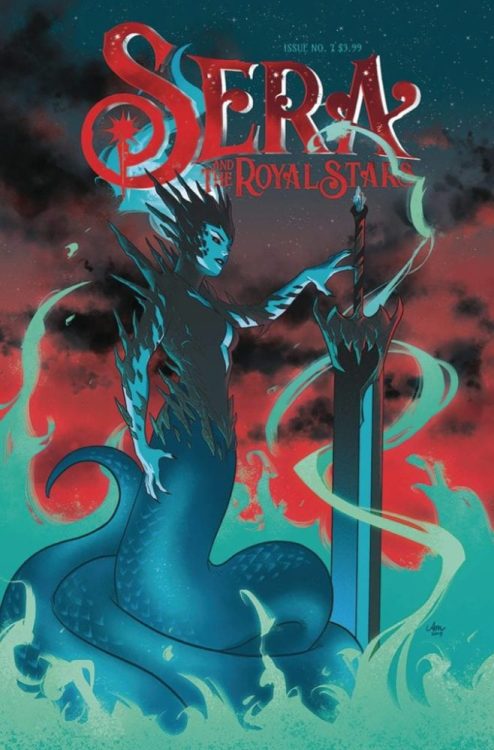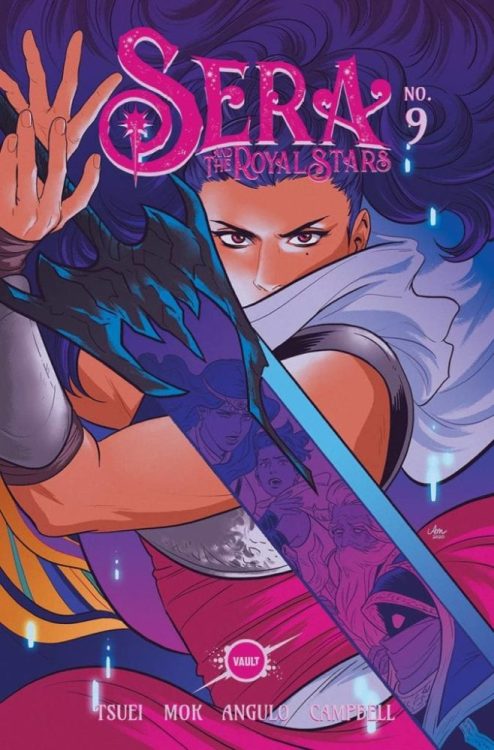Vault Comics’ Sera and the Royal Stars came to a close recently, and Monkeys Fighting Robots sat down with creators Jon Tsuei and Audrey Mok to take a look back at the stellar series (pun absolutely intended).
For the uninitiated, Sera is an epic 10-issue fantasy series by Tsuei, Mok, colorist Raúl Angulo, and letterer Jim Campbell. It’s the story of Sera, princess of Parsa, a land struck by civil war and famine. With everything going on at home, Sera is reluctantly called on a quest to find the Royal Stars — fallen stars trapped on earth — and return them to the heavens in order to save her people.
It is a beautiful and moving tale about family, loyalty, duty, and awesome battles between cosmic deities.
Read on for our full interview with Tsuei and Mok:
Monkeys Fighting Robots: How does it feel to bring Sera to a close?
Jon Tsuei: It’s bittersweet for sure. I’m incredibly proud of the work we’ve accomplished as a team, but I’m just as sad to say goodbye to this world and its cast of characters. I miss working with the team and I miss the characters. Sera will always be very close to my heart.
Audrey Mok: Definitely emotional. I feel like I came to a point in which I can finally understand the characters and the world enough to draw freely for this story, by that time, it’s close to ending. I already miss working on this story with the team. Although it’s kind of bittersweet to bring Sera to a close, I certainly had a lot of fun bringing this story to life. It has been an absolute pleasure to be working on Sera with such an amazingly talented team.
MFR: The Royal Stars we meet over the course of the series each feel so unique and well developed. Can you speak to how you two created them and fleshed them out?
JT: The main inspiration for the four main stars (Aldebaran, Antares, Fomalhaut and Regulus) comes from a Zoroastrian text called the Bundahishn. In modern day astrology these four stars are called the Royal Stars of Persia. So, I looked to various myths tied to the individual stars and their constellations to uncover their personalities. From there, I gathered some reference for what I saw in my mind’s eye and sent it over to Audrey, who worked her design magic to bring all of the stars to life. I’ll leave it to Audrey to talk more about the design process.
Fleshing out the stars was pretty organic. I’m a firm believer that stories exist in some reality separate from our own. They are living, breathing things that we as storytellers bring forth into our own plane of existence. Once you learn to see and hear these characters, they tell you where they want to go.
AM: After Jon introduced me to the main inspiration for the stars, and explained more about concepts along with various kinds of references, we began exchanging countless emails discussing the looks for the Stars, according to their personalities and their individual fighting styles. We also decided on using different color palettes for the stars inspired by their constellations, which helps a lot when it came to designing their costumes.
It was my first time working on a fantasy story, so I spent a lot of time doing research. Other than reading the history of the region Sera is based from, I drew inspiration from a lot of different sources as well. I adopted ideas from movies, game character designs, even runway shows. With these ideas, it helped develop unique designs for the four stars.
MFR: What have you each learned about making comics over the course of creating Sera? How has your perception of the medium evolved?
JT: If the past two years has taught me anything it’s that life is much bigger than comics and sometimes life is going to force you to pivot. But even when the universe is throwing you curveballs, you can absolutely find joy in your art when you’re working with such a talented and devoted group of creators. Audrey, Raúl Angulo, Jim Campbell, Adrian Wassel and everyone who worked behind the scenes at Vault made every moment of Sera something incredibly special to me and I will always cherish the time we had working together.
AM: I have had a particular visual, or a style, I wanted to try bringing into Sera in the beginning stages. As I mentioned above, this was my first fantasy story, there were a lot of things I wanted to push myself with Sera as an artist. With that specific artistic approach in mind, my art occasionally became stiff, but I also learned to remind myself from time to time that when it comes to making art, you have to let yourself “go”. Sometimes you just have to trust your instincts, and let your creativity lead you.
MFR: How did your collaboration process evolve as the series progressed?
JT: There was more back and forth in the beginning stages. We were still trying to figure out the language of Sera, both visually and thematically. But as time went on, the trust between us grew and the process quickened. We didn’t need to consult each other as often, but that didn’t stifle the quality of our work. I like to think we became more efficient and really trusted each other’s creative instincts.
AM: Totally agree with Jon here. At the early stages, there were a lot of things we needed to discuss with one another, as we were still figuring out a lot of details along the way. I think it was around issue 3 that the language of Sera had finally become solid.
MFR: What have you enjoyed most about working with one another?
JT: For me, it’s the excitement of working with Audrey. Throughout the process, I couldn’t wait to see new designs or pages by her because I was always blown away. That excitement and anticipation is fuel for my writing. Aside from the excitement I feel about Audrey’s work, I think we learned to speak the same creative language and that level of collaboration really is something special. No matter what I introduced in the script, be it a new character or a difficult scene, Audrey always delivered in a way that is truly unique to her style and voice as an artist. I couldn’t have asked for a better partner and collaborator.
AM: Reading Jon’s scripts is for sure one of the many excitements! I couldn’t wait to know where Jon will bring us in the coming issue every time I finished reading the new script.
For me, some of the most memorable parts when it comes to reading, is the emotion that you feel throughout the reading experience. Jon’s words are straightforward, with a great balance of heavy emotional and occasional comedies. As an artist, to be able to visualise the weight of those words onto paper is the most exciting part. Also, simply the fun of bringing the story to life together as a team, I enjoyed that very much.
MFR: I really love the little moments of humor sprinkled throughout Sera — they’re like perfect balances of witty dialogue and hilarious visuals.
Are these moments scripted like this, or do they come about organically in the collaboration process? How do you two manage to strike such a strong balance?
JT: That reference you have is from issue #1. We were still establishing the tone of the story at that point. I called for the panel to be funny, but I had no idea Audrey would shift her style so much to really sell the comedy. Some of my favorite panels in the series are when Audrey makes that stylistic change.
There were times when Audrey brought her own humor to the series. One of my favorite panels is when Sera, Aldebaran and Antares fall through the cave in issue #3. My script called for Aldebaran to fall with his arms crossed and looking upset. Audrey drew exactly that, but she drew him falling upside down! It made that panel so much funnier than I had intended. The story has some heavy emotional moments, but too much of that back to back would have made the story feel too heavy. The comedy throughout the series gives the reader a chance to take a breath and digest the story. As storytellers, I think we feel when it’s necessary.
AM: When it comes to comedy, I tend to exaggerate facial expressions and character gestures to convey the humour. When we were still finding the tone for Sera in our beginning stages, I remember asking Jon and the team if some of the facial expressions would be too overly exaggerated for the story. But later when we established the voice for the series, I find that the light moments of humor are just as important as the emotional heavy scenarios.
Fomalhaut almost always appeared in some of my favourite funny moments, but with his character design only showing one eye, it’s quite hard to convey humour simply through his expressions, but it was an enjoyable challenge nonetheless.
MFR: This line from issue #9 really stood out to me, and I think it’s an important question for people to consider, especially after this year: “Are the lives of those you know more precious than the lives of those you don’t? Who among us gets to make that distinction?” — Why was it important for you to explore this theme in Sera?
JT: It’s very interesting to think about where Sera is emotionally in issue #9 in relation to 2020. At that point in the story, Sera is overwhelmed by everything that’s happened thus far and part of her wants to give up because it’s too damned much. Ultimately, she puts her personal feelings aside to do what’s best for humanity. I wrote that line around February of 2020, so it was before we began to feel the full weight of the pandemic. I think Western society has a tendency to praise individualism over other characteristics, but the heroes we celebrate are often those who sacrifice themselves for others. We as individuals are a part of a greater whole and I think we should take that responsibility seriously.
AM: There are far more things we, as an individual human being, can accomplish when we work together as a team. Sometimes we need to focus on the full picture, other than what we see on the surface.
MFR: And off the back of that last question, how did 2020 change your perception of the story you were telling?
JT: Of the many themes in the story the one that is a constant in almost every issue is the theme of family. I’ve always known that family is important to me, but being forced to stay distant from my family this year has really highlighted its importance. I don’t think my perception of the story itself has changed much, but what has changed is my appreciation for the little moments you have with those you love because you never know when that could be taken away from you.
AM: I don’t think this year has changed my perception of the story itself. 2020 has been a hard time, but I’m lucky to be able to spend time with my family and loved ones. I certainly appreciate more the little things that happened around me, because you never know what will happen next.
MFR: What do you hope readers took away from Sera and the Royal Stars?
JT: Sera couldn’t have achieved what she did without the love and support of her family, friends and mentors. That’s true for all of us. If things get too hard, lean on your loved ones. You’re not alone and you don’t have to go through it alone. Love and support one another because together we can overcome the impossible.
AM: One of my favourite parts of this story, it’s actually when Sera struggled, ended up deciding to leave the Stars at the end of issue 5, and went back to her family. Leaving is a choice, a step towards the next, but not the end. Everything we do comes with a consequence. But the courage to take the first step in doing what you think is right at that moment, is a brave decision, just like how at the beginning, Sera left Setareh on a journey to free the stars.
MFR: And without spoiling the final issue, what does the future of the Royal Stars look like? Do either of you see yourselves revisiting this world in one way or another?
JT: I definitely think there are more stories to tell in that universe and I hope one day we’ll get to revisit it together. If working on the series has taught me anything, it’s that Sera and all her companions are living, breathing people who exist in a world separate from our own, but nonetheless real. You don’t have to imagine what happens next, because they’ll tell you if you listen.
AM: There are certainly a lot of stories we can build around in Sera’s world, and I would love to tell them with the team if that time comes!
Thank you again to Jon Tsuei and Audrey Mok for taking the time to talk with us. Sera and the Royal Stars #10 is out now.


